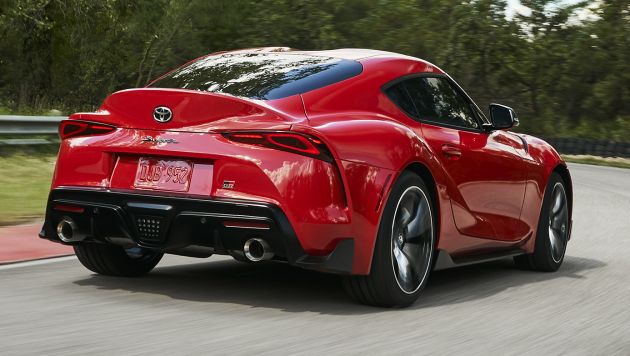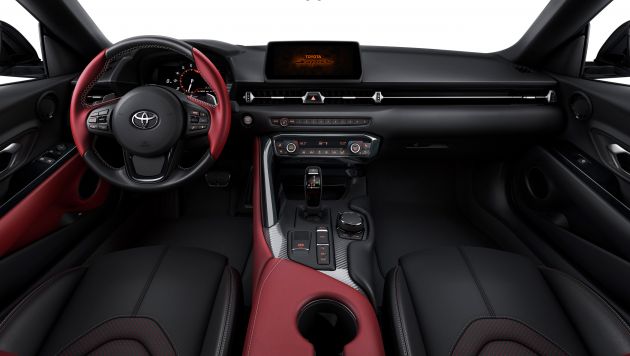Here it is, the real deal. No more spyshots, no more teasers, no more leaks. You’re looking at the all new Toyota GR Supra in all its glory, and there’s a lot to unpack. So let’s get to it.
Yes, the early rumours were true – the new fifth-generation A90 Supra gets a GR prefix to its name, marking its status as the first global model from in-house motorsports arm Toyota Gazoo Racing. And yes, as you all know by now, it’s based on the latest G29 BMW Z4 as part of a sports car collaboration with Munich, but there’s a bit more to this front-engined, rear-wheel drive sports car than that.
The exterior, as we’ve seen countless times before, is perhaps its biggest differentiator. Derived from the stunning FT-1 Concept from 2014, it borrows a number of styling cues from past Toyota sports cars, such as the rounded headlights (now with stacked LED projectors for a distinctive lighting signature) and slim tail lights of the fourth-gen A80 Supra, as well as the double-bubble roof of the 2000GT.
The prominent nose that splits the air intakes, meanwhile, is very Formula 1 – even though Toyota won’t draw parallels to its ill-fated F1 project. There’s also a wraparound windscreen design with blacked-out A-pillars, faux vents and inlets aft of the front wheels and ahead of the rear wheels, a sizeable rear diffuser with twin tailpipes and a upswept integrated bootlid spoiler that Toyota says is inspired by the A80’s enormous rear wing. And the F1-style LED central rear light? That’s for reverse.
Inside, the Supra borrows much of its switchgear (along with its door mirrors and door handles) from BMW – owners of the F30 3 Series will find plenty familiar here, down to the stubby electronic gearlever. The iDrive system, complete with its tiled interface, has also been lifted straight from Munich, but the design of the 8.8-inch digital instrument cluster with its central rev counter is unique to the Toyota.
So is the rest of the cabin design, which features a flat, horizontal dashboard with full-width air vents, plus a padded leg bolster for the driver that gives the car a cockpit-like feel. You’ll also find a small three-spoke steering wheel, sports seats with integrated headrests, an optional colour head-up display and a choice of either a 6.5-inch central display or a 8.8-inch touchscreen – again, similar to what you’ll find on a BMW.
Alright, enough of the superfluous bits, let’s talk numbers. The Supra shares the same 2,470 mm wheelbase as the Z4 (some 100 mm shorter than the 86), but its 4,380 mm length, 1,865 mm width and 1,295 mm height make it 56 mm longer, one millimetre wider and nine millimetres lower. All this results in a wheelbase-to-tread ratio of 1.55, said to be one of the smallest among mainstream sports cars, making for better agility.
Other claims include a lower centre of gravity compared to the 86 (despite having an inline engine vis-à-vis the 86’s flat boxer mill), a perfect 50:50 weight distribution and a steel-and-aluminium structure that is 2.5 times stiffer than the carbon fibre-bodied Lexus LFA.
Under the bonnet, the Supra will be offered with a choice of two engines in three different outputs, all from BMW. The base 2.0 litre turbocharged four-cylinder on the SZ model produces 197 PS from 4,500 to 6,500 rpm and 320 Nm of torque between 1,450 to 4,200 rpm – essentially the 20i tune found on most BMWs. It sprints from zero to 100 km/h in a respectable 6.5 seconds.
Step up to the SZ-R model and those numbers are bumped up to 30i spec – 258 PS from 5,000 to 6,500 rpm and 400 Nm between 1,550 to 4,400 rpm, cutting the acceleration time to 5.2 seconds. But it’s the evocative-sounding RZ that gets the top-dog 3.0 litre straight-six, producing 340 PS from 5,000 to 6,500 rpm and 500 Nm between 1,600 and 4,500 rpm. This one does the century sprint in just 4.3 seconds.
For now, all engines are mated to a standard eight-speed ZF automatic transmission, but Toyota’s assistant chief engineer Masayuki Kai did previously say that a manual gearbox is a possibility (unlike the auto-only Z4) depending on market feedback, so there’s still some hope yet for purists.
As for the chassis, the Supra features double-jointed MacPherson struts at the front and multi-link rear suspension, with optional Adaptive Variable Suspension damping and a electronic locking rear differential that is tuned to work in tandem with the Vehicle Stability Control (VSC) system. So far, so BMW, but apparently the Supra has been developed independently from Munich since 2014, so we’ll see how it drives.
Toyota has yet to confirm pricing for the Supra in Japan, but over in the US, the car will retail from US$49,990 (RM204,900). That’s with the 3.0 litre engine – the only one confirmed for North America so far – and it rises to US$53,990 (RM221,200) for the more well-equipped 3.0 Premium. The limited Launch Edition, essentially a Premium but with red door mirrors and black 19-inch alloys, goes for US$55,250 (RM226,400).
Source: Read Full Article





